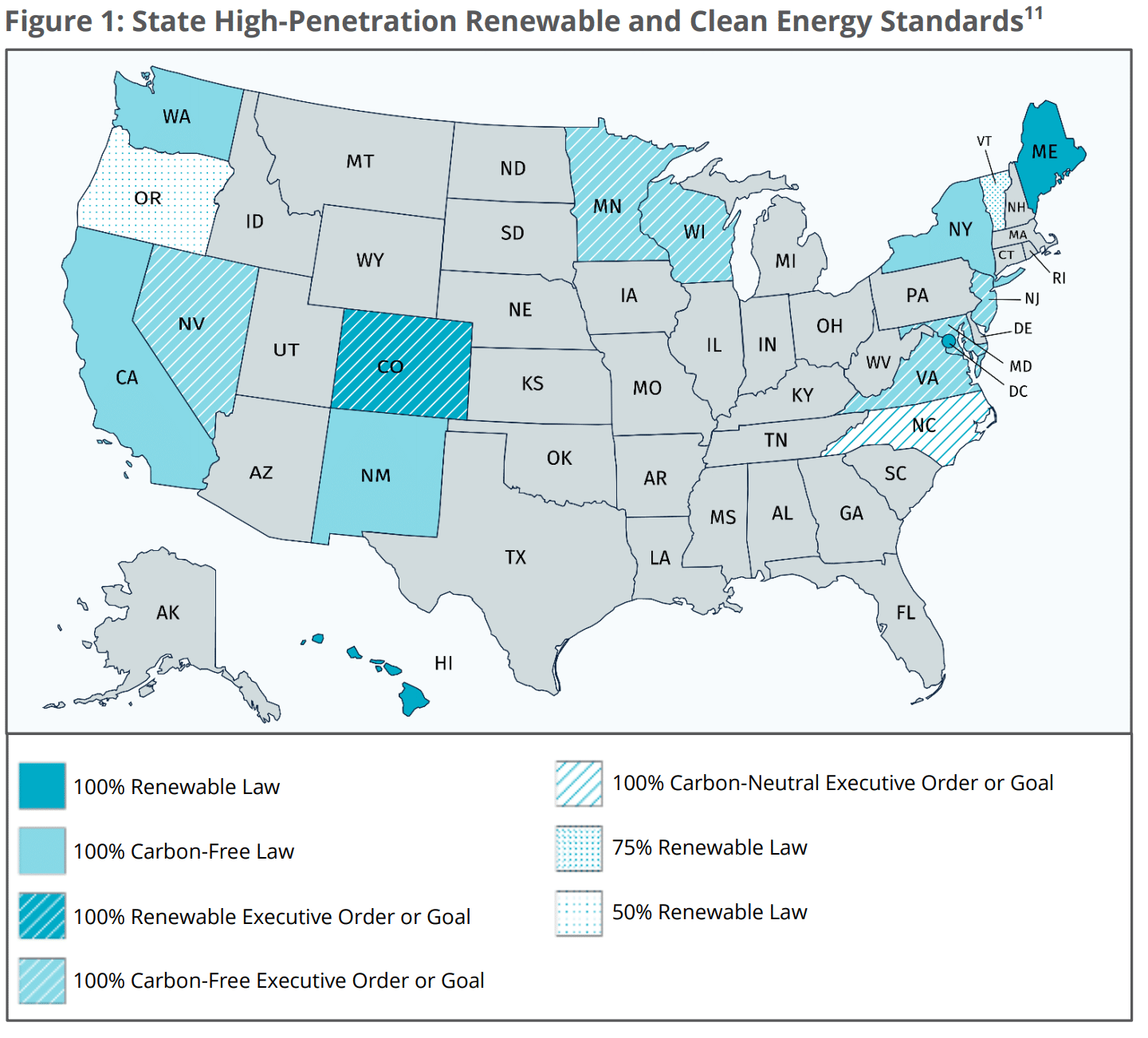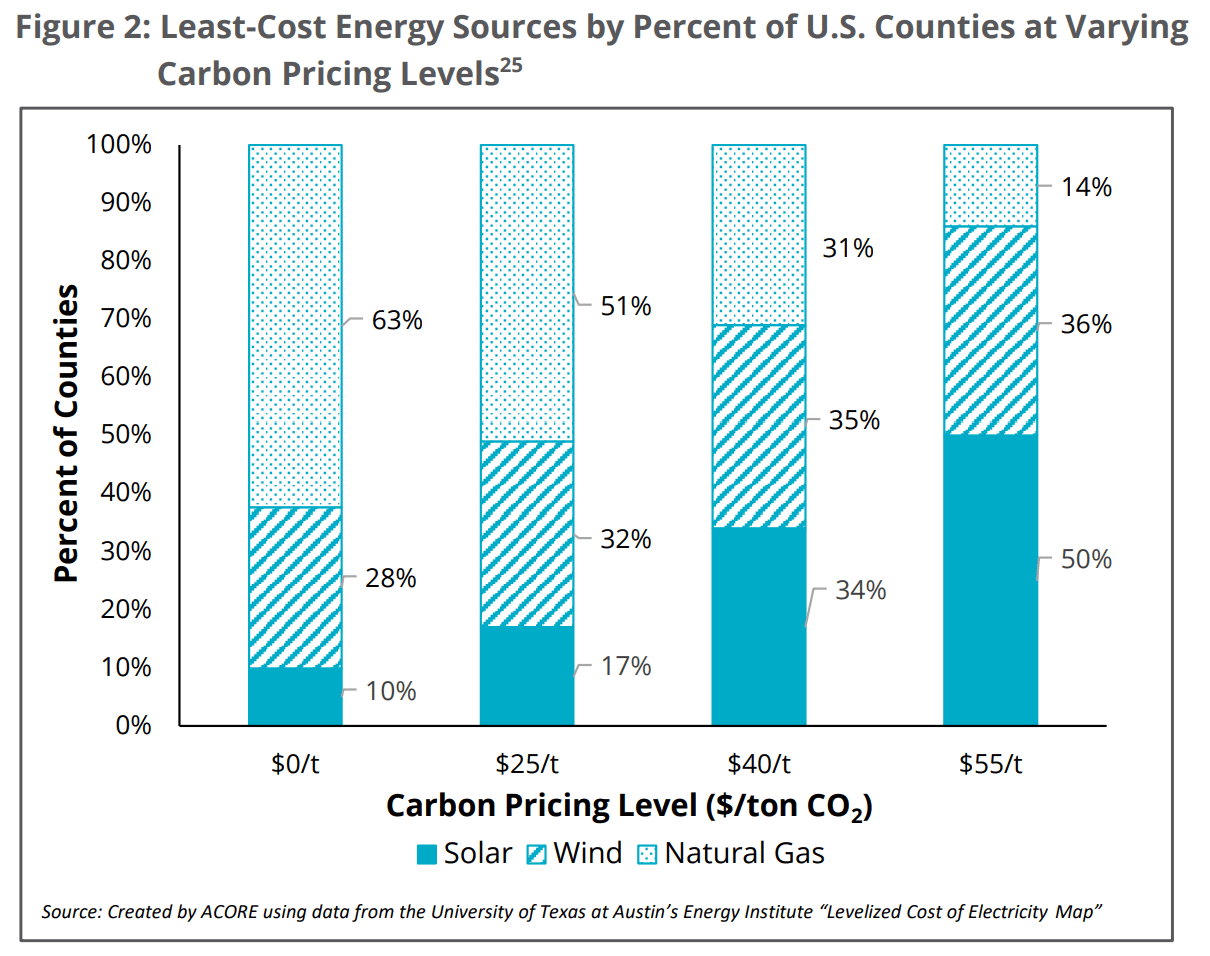The American Council on Renewable Energy (ACORE) has presented four complementary policy ideas that the group believes will clean up the U.S. electricity grid.
The first idea is a 50% renewable energy standard, but designed to not inhibit the goals of states that have greater ambitions. Second, a continuation of the 30% investment tax credit or 2.4¢ production tax credit that solar and wind have enjoyed — but expanded to include all clean energy technologies. Third is a carbon tax, with strong attention paid to both start rate (ranging from $15 to $55/ton) and rate of increase. And last is upgrading the electricity transmission system — with a specific recommendation to refocus Congress on siting of transmission lines, and for FERC to incentivize a more robust and efficient transmission system.

The report, titled Policy Options That Most Effectively Put Renewable Energy to Work, notes that just over 1 TW of utility-scale, electric generation capacity is renewable (22%), while two-thirds of our generation capacity is fossil-based. To replace this capacity by 2050, we’ll need deploy about 30 GW a year of renewable energy.
The first recommendation is to set a federal renewable or zero-carbon energy standard of 50%. The technologies considered should be broad: wind, solar, hydropower, ocean, tidal, hydrokinetic, geothermal energy, and other zero-carbon renewable resources. The timelines should be consistent with scientific recommendations that mitigate climate change. The report suggests the business continuity that was created with the various state programs is evidence of the potential value of a federal program. In the same breath, the authors also reminded policy creators to be conscious of more ambitious state policies and to be sure to craft legal text that doesn’t hinder leaders.
The second guidance was for a technology-neutral tax credit, much like what wind and solar get, for any facility that delivers clean electricity. Senator Ron Wyden’s (D-OR) recently proposed “Clean Energy for America Act” was pointed out, with its support of any clean electricity facility that is at least 35% cleaner than the average. The legislation says any zero-emissions facilities would receive a production tax credit of up to 2.4¢/kWh or an investment tax credit of up to 30%, at the election of the taxpayer.
The legislation gets rid of multiple incentives for fossil fuel companies, including “the expensing of intangible drilling costs, percentage depletion, deductions for tertiary injectants, and credits for enhanced oil recovery and marginal oil wells.”

In formulating the carbon tax, the authors included the above model from the University of Texas to give some round figures to consider when implementing the tax. Note that they didn’t even consider coal, but skipped straight to gas. In the below chart, using the U.S. Energy Information Administration’s 2019 Annual Energy Outlook model, the group plugged in the above first-year carbon prices, and added annual rates of increase spanning <1% to 100%.
The outcome and lessons learned were that all the proposals reduce carbon emissions over the next 15 years by more than 20% — but that any of the starting amounts could end up with the greatest emissions reduction depending on its annual increase. Note that the “Climate Action Rebate Act,” starting at $15/ton CO2 — with a 100% increase in year one and a continued $15/year increase — ends up reducing emissions the most in the long term.
The authors also suggest considering a dividend for the poor, some math to make sure local goods don’t suffer against countries who don’t implement a tax of this nature, and a smarter transition away from coal and gas in order to not build power plants that ratepayers will be shutting down early.

Lastly, the authors say its time we refocused on the power grid. They note a study which found that a “large transmission network” would be most effective at getting a wind and solar penetration of approximately 55%, and a Brattle Group analysis that said “building transmission to access high quality but distant renewable resources is often more cost-effective than making use of more local, but lower quality resources.”
Other research suggests that that the U.S. could get to 100% renewables with a mix of oversized solar and wind, some energy storage and a nationwide HVDC transmission network.
The report suggests that Federal Energy Regulatory Commission Order No. 1000 be refined to motivate use of advanced technologies and grid optimization methods, while taking into account cheap renewable electricity. Additionally the report looks to get Congress to reaffirm its siting authority by “restoring Congressional intent of the Energy Policy Act of 2005.” This would make upgrading the power grid an action of national interest as part of a broader climate plan.
This content is protected by copyright and may not be reused. If you want to cooperate with us and would like to reuse some of our content, please contact: editors@pv-magazine.com.








Thanks, John! Love the graphs. Here’s to hoping we get some sensible renewables legislation sometime soon.
“”The legislation gets rid of multiple incentives for fossil fuel companies, including “the expensing of intangible drilling costs, percentage depletion, deductions for tertiary injectants, and credits for enhanced oil recovery and marginal oil wells.””
Right here IS the problem and has been the problem for about 80 years in tax laws that allow such considerations of an industry that’s 150 years old and ubiquitous. I’m sure over the years, there have been many “bills” that would have taken care of this discrepancy. The problem with “bills” is the “process” of committees and bill wording changes until the bill goes to vote. Some bills don’t reflect the original intent of the final bill. The practice of using a “bill” as a place to dump changes in the law for items that have NOTHING to do with the original bill. These spot bills or “riders” should be illegal at the Constitutional level.
Fortunately, solar PV and wind generation have proven themselves cost effective even though they are intermittent generation resources, the cost of energy storage coming down will deliver a “system” that will be much cheaper to construct, operate and maintain than any fueled generation resource online now. The will of the people is probably the major driving factor for the use of the technology, over the “political will” of our representatives.